Description
SAP BASIS is the technical foundation that enables SAP applications to function. It stands for “Business Application Software Integrated Solution” and covers a wide range of activities, from system installation and configuration to managing SAP system landscapes, performance tuning, and user management. This course takes you from a beginner to an advanced level, enabling you to perform critical SAP BASIS operations, maintenance tasks, and advanced configurations.
Prerequisites
To make the most out of this course, the following prerequisites are recommended:
- Basic Computer Skills: Familiarity with general IT concepts, operating systems (especially Linux and Windows), and networking.
- Knowledge of Databases: Understanding how relational databases (like Oracle, SAP HANA, or MS SQL) work.
- Understanding ERP Systems: Basic knowledge of ERP systems and their function in businesses.
- Basic SAP Knowledge (Optional): Some exposure to the SAP system, though the course is designed to accommodate absolute beginners.
- Virtualization and Cloud Basics (Optional): Helpful but not mandatory for advanced topics.
Table of Contents
1. Introduction to SAP BASIS
- What is SAP BASIS?
- Role of a BASIS administrator
- SAP system architecture overview
- Key components of SAP BASIS
2. SAP System Installation
- SAP NetWeaver architecture
- Preparing for installation (Prerequisites, Sizing, Hardware/Software)
- SAP ECC/NetWeaver installation on different OS platforms
- Post-installation checks
3. SAP System Administration
- Starting and stopping SAP systems
- SAP Logon and SAP GUI overview
- User creation and role assignment
- Transport management system (TMS)
- Working with SAP profiles (RZ10, RZ11)
4. Client Administration
- What is an SAP Client?
- Creating and managing clients
- Client copy, export, and import
- Client deletion and administration tasks
5. SAP User Management
- Creating users
- Authorization concepts and profiles
- Managing roles and permissions (PFCG)
- Managing passwords and user sessions
6. SAP System Monitoring
- Monitoring system performance using transaction codes (ST22, SM50, SM66)
- Monitoring work processes and system logs
- Background job scheduling and monitoring
- SAP EarlyWatch Alerts
7. Database Administration for SAP
- Basics of database administration (Oracle, HANA, SQL Server)
- Database backup and recovery
- Database monitoring and performance tuning
- Understanding and managing SAP HANA architecture
8. SAP Transport Management System (TMS)
- Introduction to SAP TMS
- Creating and configuring transport routes
- Importing and exporting transport requests
- Troubleshooting transport issues
9. Patch Management and Upgrades
- Understanding SAP Support Packages and Enhancement Packages
- Applying SAP patches and upgrades
- SAP kernel upgrade
- Troubleshooting issues during patching/upgrades
10. SAP Security and Authorizations
- SAP security concepts
- Role-based authorization management
- Secure Single Sign-On (SSO)
- Security audits and user tracking
11. SAP Backup and Recovery
- Backup strategies for SAP systems
- Restoring SAP systems from backups
- Managing database backups
- Disaster recovery planning
12. Advanced SAP Basis Topics
- Advanced performance tuning
- SAP HANA administration
- SAP system copy and system refresh
- Implementing high availability (HA) and disaster recovery (DR)
13. SAP in the Cloud
- Introduction to SAP Cloud solutions
- SAP on AWS, Azure, and Google Cloud
- Hybrid cloud solutions for SAP
- Cloud integration with on-premises systems
14. SAP S/4HANA Basics
- What is SAP S/4HANA?
- SAP S/4HANA migration overview
- Key differences between ECC and S/4HANA
- Preparing for an SAP S/4HANA migration
15. Troubleshooting and Best Practices
- Common SAP BASIS errors and solutions
- SAP system logs and troubleshooting techniques
- Best practices for SAP BASIS administration
- Performance optimization techniques
This course is structured to provide hands-on, practical knowledge, making it easy for beginners to learn while giving more advanced users the tools to manage and troubleshoot real-world SAP BASIS environments effectively.






